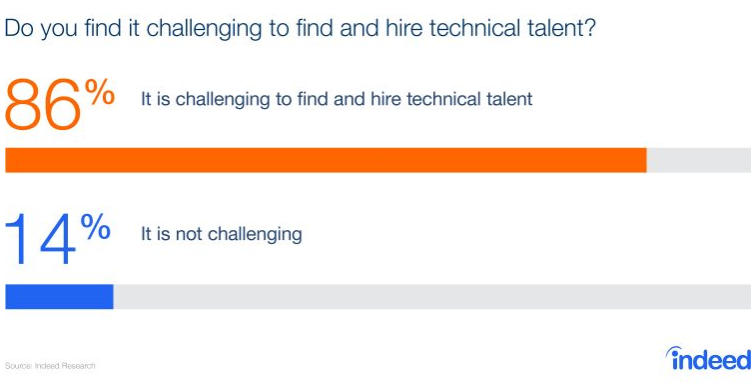There’s a high demand for coders in the market. Every organization is looking for the best talents possible. Apart from companies that deal in the technology sector, there are a lot of companies that rely on coders. So, how to hire a coder? As per Glassdoor, eight out of the top 25 jobs are in tech. Software engineers in today’s world can find themselves working at Apple, a hospital, or with an automotive manufacturer.
A report by the Bureau of Labor Statistics (BLS) says that the employment rate of computer programmers might suffer an 8% drop, i.e., 302,200 positions over the next decade, as businesses nowadays outsource projects to less expensive contract workers overseas.
However, a report by burning glass suggested in 2015, it was estimated that over 7 million job openings required coding skills. As a result, coding has become a core skill that bolsters a candidate’s chance of demanding a high salary.
In this COVID-19 era, if a company is planning to pay handsomely to a coder, the recruiter needs to make sure they hire coders online and try to get the best out of the talent pool. This can't happen if you only rely on the resume. The recruiter must assess a candidate's coding skills, which only happens via skill assessment platforms. Learn more about skills assessment platform about here are the top options of online coding interview tools to choose from.
This isn’t easy as the recruiters lack technical skills-

Therefore, a new test called the coding simulator has revolutionized the hiring process. The coding simulator helps you understand the logic, basic fundamentals, and confidence of the candidate. It comes with a feature called code replay, wherein you can check the step-by-step process used by the candidate.
What is a Coding Simulator?
A coding simulator is a type of assessment wherein candidates write code from scratch. Then the code is evaluated based on different factors like, whether or not it satisfies the test cases mentioned in the assessment, the code is simple or complex. This helps the hiring manager to evaluate the thinking process, logical reasoning. Not only this, coding simulators are designed to keep checking the basic fundamentals of the candidate and analytical skills.
Online coding tests create a real-time environment for the candidates so that they can feel comfortable. This also helps the hiring manager assess the candidate’s ability to work on real projects. This also gives an insight into the practical concepts and their problem-solving ability.
5 Benefits of Coding Simulator
1. Code Replay
- It is a line-by-line coding by the candidates. This helps to understand code cleanliness, memory optimization, accuracy, and logic.
- Code replay helps in identifying good programmers from the average ones.
2. Code Plagiarism
- Detect unoriginal code and software similarity with the most advanced plagiarism detection solution.
- iMocha compares code submissions both internally and externally.
3. Real-Time coding environment
- Ideally, a platform should replicate an IDE that helps in providing a real-time online coding environment for the candidate.
- Integration with editors like Vims and Emacs gives a great boost to the real-time experience. A theme editor that switches from light to dark is also appreciated.
4. Scoring Made Custom
- Every test case should have an individual score allotted to them and the candidate should be scored on the basis of each test case (passed or failed).
- The scoring parameters that could fall under each test care are correctness of the code, time taken, simplicity or complexity code, and difficulty level.
- Only when the set parameters are fulfilled then the candidate should be given a score.
5. Candidate Friendly
- Online coding tests won’t be needed if they aren’t feasible. The feasibility factor not only includes the organization sending out the test but also the candidate taking it.
- The real-time coding environment with a theme and keyboard editors in sync will help to enhance the candidate experience.
- The test should be fair-to-all, as in the coding question should be set keeping in mind the experience of the candidate appearing for the test. And, the appropriate amount of time should be allotted to the candidate.
- An internal test should be taken to set the benchmark for the same. Providing a positive candidate will help in employer branding.
Conclusion
The report that gets generated should ideally look like the below image-



